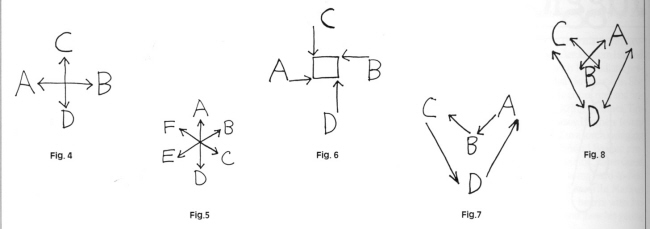 |
Page 30 Winter 1991 - 92
|
It
is quite natural to add clubs to a line. For each club you add, add
one spin to someone's throw. Ten is usually done with the back person
throwing long doubles. For eleven, have the front person throw doubles
too. With twelve, the dropbacks should have an added spin and maybe
the long throw can be a triple to provide yet more time. The person(s)
throwing doubles or triples should start with the extra cIub(s).
The
Box The
box makes an impressive juggling feat possible without much work. In
this formation, two pairs of jugglers are passing independently except
for the fact that their passes cross. Figure 4 shows a box in which
jugglers A and B are exchanging passes and jugglers C and D are doing
the same.
To
avoid collisions, we just make sure that the two pairs of passers
either (a) pass alternately so that pairs of clubs take turns going
through the middle or (b) pass at exactly the same time. These are the
alternating box and the simultaneous box. We'll assume that each pair
of jugglers is passing six clubs, but similar boxes can also be
executed with each pair passing seven or more clubs (at last summer's
St. Louis festival, an 18club box
was demonstrated in the club passing workshop by Doubble Troubble and
Happenstance).
The
Alternating Box The
easiest rhythm for the alternating box has each pair passing a
4-count, but the pairs are out of phase so that when one is passing,
the other is doing a right hand self. This is very easy, but still the
two pairs have to keep juggling at the same speed or one will
eventually catch up with the other. To start this box, simply use the
rule above: the second pair should pass when the first pair is doing a
right hand self.
A
slightly harder alternating box has each pair passing a 2-count, but
when one pair is passing, the other is doing a left self. There is
less room for error here, but it is still not terribly hard. One way
to start is to have the second pair start with two clubs in the left
hand and begin with a left self when the first pair is passing.
A
very hard alternating "box" is a pattern called entropy,
which has three evenly spaced pairs (instead of two) passing through a
common midpoint, each pair passing a 2-count (see Fig. 5). Here the
pairs are out of phase by 2/3 of a count and the timing has to be very
precise. Keep your throws somewhat inside to get through the middle as
easily as possible. It takes six experienced passers with very good
rhythm to pull this off successfully. One way to start entropy is to
have one person in each of the
second and third pairs start with four clubs (jugglers B and C in Fig.
5) so that only those two people have to time their starts carefully.
Another
possibility with six people is to have each pair passing in a 3-ct,
with successive pairs out of phase by one count (as in the four-person
2-count alternating box above). Again, keep the passes inside in these
alternating boxes. The
Simultaneous Box The
simultaneous box has everyone in the box pattern passing at once. Can
this possibly work? Yes! It does require precise timing. If you try
this with four people who have never passed together before, it'll
likely take a while before you all agree on a common speed - and it
may never happen. Each of you will need to be prepared to adjust your
speed. .
To
avoid collisions, keep your passes outside in any simultaneous box.
That means not only throwing to a point well outside your partner's
shoulder, but throwing from a point about a foot outside your leg.
To
keep everybody throwing at the same time on each pass, try the
following useful trick. Each of you should watch the person on your
right and throw at exactly the same time that person does. It's not
hard to see that person while you continue passing with your partner,
and it definitely helps keep the group's passes locked together in
time. Make
sure that you all start at the same time.
You
might find that a slow start helps you to do that. Try also to keep
the passing speed slow, since it's generally easier to stay together
at a slower speed because it allows
for correcting slight errors better than a fast passing speed does.
Now,
the reason that the simultaneous box works at all is that the clubs
don't all go through the same point. In fact, with perfect timing,
they simultaneously reach the four comers of a little square, about
two to three feet on a side, in the middle of the box (see Fig. 6).
Then each club travels along one side of the little square, getting
out of the way of the club behind it while the
club in front gets out of its way. If all the clubs
reach the comers of the square at the same time,
and if the square is big enough, then no collisions will
occur. Making the throws wide (at the throw and at the catch) makes
the little square bigger, and thus allows a bigger margin of error. |
 |